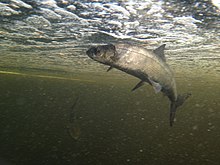Atlantic whitefish
| Atlantic whitefish | |
|---|---|

| |
| Scientific classification | |
| Domain: | Eukaryota |
| Kingdom: | Animalia |
| Phylum: | Chordata |
| Class: | Actinopterygii |
| Order: | Salmoniformes |
| Family: | Salmonidae |
| Genus: | Coregonus |
| Species: | C. huntsmani
|
| Binomial name | |
| Coregonus huntsmani W. B. Scott, 1987
| |
| Synonyms | |
| |
The Atlantic whitefish (Coregonus huntsmani) is a coregonine fish inhabiting some freshwater lakes within Nova Scotia, Canada.[2][3] It is known to survive only in the Petite Rivière watershed as landlocked populations. Earlier it was also found in the Tusket and Annis rivers of Nova Scotia. Those populations were anadromous, migrating to the estuary to feed while breeding in freshwater.[4]
C. huntsmani was originally designated Coregonus canadensis, but the species name was changed in 1987. Other common names that C. huntsmani is known by are Acadian whitefish and sault whitefish. The species was designated as an endangered species by the IUCN in 1986 and vulnerable in 1996. It is now considered critically endangered due to the consequences of dam building and introduced predators such as smallmouth bass and chain pickerel.[5] Nova Scotia prohibited the taking of Atlantic whitefish under the Canadian Fisheries Act. Other conservation actions for the species include captive breeding and restocking, as well as control of the introduced predators.[6]
The Atlantic whitefish has a typical salmonid body shape and is silvery on the sides and underside with a dark blue to dark green back. The landlocked populations feed on insects and small fish. The reproduction of Atlantic whitefish in nature has not been observed.
The narrowly endemic Atlantic whitefish is genetically distinct from the lake whitefish (Coregonus clupeaformis) and the cisco (Coregonus artedi), which both are widespread across much of continental North America. Phylogenetic evidence indicates that the species is the most basal member of the widespread and speciose genus Coregonus, with its lineage diverging from the rest of the Coregonus species during the mid-Miocene, about 15 million years ago. It is even more basal than the genus Stenodus, making Coregonus paraphyletic with respect to Stenodus.[5][6][7]
References[edit]
- ^ Smith, K. (2017). "Coregonus huntsmani". IUCN Red List of Threatened Species. 2017: e.T5379A81422722. doi:10.2305/IUCN.UK.2017-3.RLTS.T5379A81422722.en. Retrieved 7 November 2022.
- ^ "Coregonus huntsmani, Atlantic whitefish". www.fishbase.de. Retrieved 14 September 2022.
- ^ Scott, W. B. (14 February 2011). "A new name for the Atlantic whitefish: Coregonus huntsmani to replace Coregonus canadensis". Canadian Journal of Zoology. 65 (7): 1856–1857. doi:10.1139/z87-282.
- ^ Murray, Kimberly (2007). Population genetic assessment of the endangered Atlantic whitefish, Coregonus huntsmani, and the lake whitefish, Coregonus clupeaformis, in Atlantic Canada. Library and Archives Canada = Bibliothèque et Archives Canada. ISBN 978-0-494-16629-1. OCLC 248936682.
- ^ a b Whitelaw, John. Atlantic whitefish (Coregonus huntsmani) culture handbook. ISBN 978-0-660-02539-1. OCLC 980875338.
- ^ a b Auld, Alison. "Rescuing an ancient fish species on the brink of extinction". phys.org. Retrieved 14 September 2022.
- ^ Crête-Lafrenière, Alexis; Weir, Laura K.; Bernatchez, Louis (5 October 2012). "Framing the Salmonidae Family Phylogenetic Portrait: A More Complete Picture from Increased Taxon Sampling". PLOS ONE. 7 (10): e46662. Bibcode:2012PLoSO...746662C. doi:10.1371/journal.pone.0046662. ISSN 1932-6203. PMC 3465342. PMID 23071608.
- Froese, Rainer; Pauly, Daniel (eds.) (2006). "Coregonus huntsmani" in FishBase. 06 2006 version.
- Recovery potential assessment of Atlantic whitefish (Coregonus huntsmani) Canadian Science Advisory Secretariat Science Advisory Report 2009/051
- "Coregonus canadensis". Integrated Taxonomic Information System. Retrieved 12 June 2006.
External links[edit]
- Atlantic whitefish Fisheries and Oceans Canada www.dfo-mpo.gc.ca
- Nova Scotia Fisheries and Aquaculture factsheet
- Coregonus canadensis World Register of Marine Species entry

